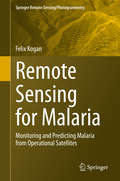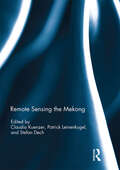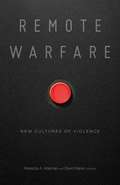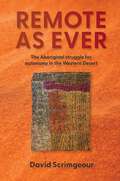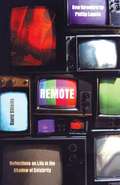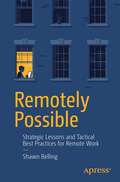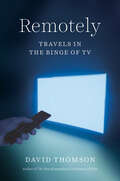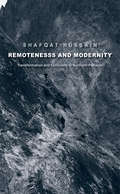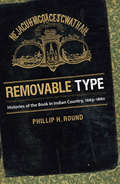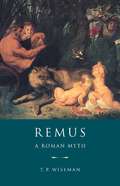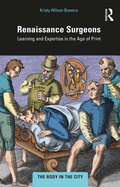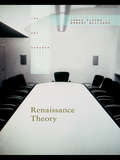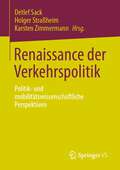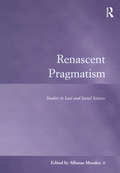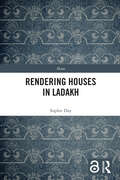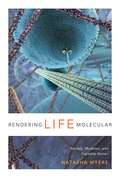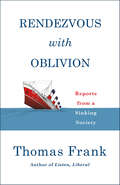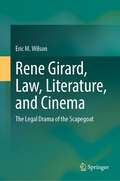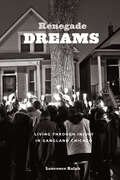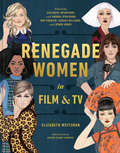- Table View
- List View
Remote Sensing for Malaria: Monitoring and Predicting Malaria from Operational Satellites (Springer Remote Sensing/Photogrammetry)
by Felix KoganThis book presents research using high-resolution operational satellite data for monitoring and assessing numerically how to reduce the area and intensity of malaria outbreaks. Satellite data and imageries a powerful and effective tool for malaria monitoring and reduction of the number of affected people as it bypasses the limitations imposed by the dearth of near-the-ground weather data in many malaria-prone areas. With this in mind, this volume provides readers with:In-depth information in monitoring signs of malaria from operational polar-orbiting satellitesExamples of country-specific models for predicting malaria area (1 and 4 km2 resolution) and intensityInformation on the how the effects of climate change on malaria outbreak area and intensity can be monitoredA new Vegetation Health (VH) methodology to estimate vegetation moisture, temperature and moisture/temperature conditions as indicators of malaria vector activityAdvice to users on the application of VH technology for early assessments of malaria area, intensity and risk levelRemote Sensing for Malaria is intended for an audience of public health practitioners, environmentalists, and students and researchers working in spatial epidemiology and disease prevention.
Remote Sensing the Mekong
by Claudia Kuenzer Stefan Dech Patrick LeinenkugelThe Mekong Basin in Southeast Asia is one of the largest international river basins in the world. Its abundant natural resources are shared by six riparian countries and provide the basis for the livelihoods of more than 75 million people. However, ongoing socio-economic growth and related anthropogenic interventions impact the region’s ecosystems, and there is an urgent need for the monitoring of the basin's land surface dynamics. Remote sensing has evolved as a key tool for this task, allowing for up-to-date analyses and regular monitoring of environmental dynamics beyond physical or political boundaries and at various temporal and spatial scales. This book serves as a forum for remote-sensing scientists with an interest in the Mekong River Basin to present their recent basin-related works as well as applied case studies of the region. A broad range of sensors from high to medium resolution, and from multispectral to SAR systems, are applied, covering topics such as land cover/land use classification and comparison, time series analyses of climate variables, vegetation structure and vegetation productivity, as well as studies on flood mapping or water turbidity monitoring. This book was originally published as a special issue of the International Journal of Remote Sensing.
Remote Warfare: New Cultures of Violence
by David Kieran Rebecca A. AdelmanConsiders how people have confronted, challenged, and resisted remote warfare Drone warfare is now a routine, if not predominant, aspect of military engagement. Although this method of delivering violence at a distance has been a part of military arsenals for two decades, scholarly debate on remote warfare writ large has remained stuck in tired debates about practicality, efficacy, and ethics. Remote Warfare broadens the conversation, interrogating the cultural and political dimensions of distant warfare and examining how various stakeholders have responded to the reality of state-sponsored remote violence.The essays here represent a panoply of viewpoints, revealing overlooked histories of remoteness, novel methodologies, and new intellectual challenges. From the story arc of Homeland to redefining the idea of a &“warrior,&” these thirteen pieces consider the new nature of surveillance, similarities between killing with drones and gaming, literature written by veterans, and much more. Timely and provocative, Remote Warfare makes significant and lasting contributions to our understanding of drones and the cultural forces that shape and sustain them.Contributors: Syed Irfan Ashraf, U of Peshawar, Pakistan; Jens Borrebye Bjering, U of Southern Denmark; Annika Brunck, U of Tübingen; David A. Buchanan, U.S. Air Force Academy; Owen Coggins, Open U; Andreas Immanuel Graae, U of Southern Denmark; Brittany Hirth, Dickinson State U; Tim Jelfs, U of Groningen; Ann-Katrine S. Nielsen, Aarhus U; Nike Nivar Ortiz, U of Southern California; Michael Richardson, U of New South Wales; Kristin Shamas, U of Oklahoma; Sajdeep Soomal; Michael Zeitlin, U of British Columbia.
Remote Work Revolution: Succeeding from Anywhere
by Tsedal Neeley“I often talk about the importance of trust when it comes to work: the trust of your employees and building trust with your customers. This book provides a blueprint for how to build and maintain that trust and connection in a digital environment.” —Eric S. Yuan, founder and CEO of ZoomA Harvard Business School professor and leading expert in virtual and global work provides remote workers and leaders with the best practices necessary to perform at the highest levels in their organizations. The rapid and unprecedented changes brought on by Covid-19 have accelerated the transition to remote working, requiring the wholesale migration of nearly entire companies to virtual work in just weeks, leaving managers and employees scrambling to adjust. This massive transition has forced companies to rapidly advance their digital footprint, using cloud, storage, cybersecurity, and device tools to accommodate their new remote workforce.Experiencing the benefits of remote working—including nonexistent commute times, lower operational costs, and a larger pool of global job applicants—many companies, including Twitter and Google, plan to permanently incorporate remote days or give employees the option to work from home full-time. But virtual work has it challenges. Employees feel lost, isolated, out of sync, and out of sight. They want to know how to build trust, maintain connections without in-person interactions, and a proper work/life balance. Managers want to know how to lead virtually, how to keep their teams motivated, what digital tools they’ll need, and how to keep employees productive.Providing compelling, evidence-based answers to these and other pressing issues, Remote Work Revolution is essential for navigating the enduring challenges teams and managers face. Filled with specific actionable steps and interactive tools, this timely book will help team members deliver results previously out of reach. Following Neeley’s advice, employees will be able to break through routine norms to successfully use remote work to benefit themselves, their groups, and ultimately their organizations.
Remote as Ever: The Aboriginal Struggle for Autonomy in Australia's Western Desert
by David ScrimgeourIn Remote as Ever, David Scrimgeour tells the story of his working life as a doctor in isolated communities in Australia's Western Desert in the late 1970s. Being involved in the Homelands movement and the Aboriginal community-controlled health campaign gave him significant insight into the strength of the Aboriginal struggle for autonomy-a struggle too often undermined by government policy. In an account replete with strong controversies and stronger personalities, Scrimgeour demonstrates that the future of these communities, and indeed the health of its individual members, remain in the balance.
Remote: Reflections on Life in the Shadow of Celebrity
by Phillip Lopate David ShieldsIn this truly one-of-a-kind book, the author/narrator--a representative, in extremis, of contemporary American obsession with beauty, celebrity, transmitted image--finds himself suspended, fascinated, in the remoteness of our wall-to-wall mediascape. It is a remoteness that both perplexes and enthralls him. Through dazzling sleight of hand in which the public becomes private and the private becomes public, the entire book-clicking from confession to family-album photograph to family chronicle to sexual fantasy to pseudo-scholarly footnote to reportage to personal essay to stand-up comedy to cultural criticism to literary criticism to film criticism to prose-poem to litany to outtake-becomes both an anatomy of American culture and a searing self-portrait. David Shields reads his own life--reads our life--as if it were an allegory about remoteness and finds persuasive, hilarious, heartbreaking evidence wherever he goes.
Remotely Possible: Strategic Lessons and Tactical Best Practices for Remote Work
by Shawn BellingMany organizations are shifting to a remote workforce in order to be competitive and many more are built as remote-first outfits. The sudden global experiment brought on by the COVID-19 pandemic has proven that remote teams are in fact possible and widely effective across industries when done right. Remotely Possible addresses the challenges and opportunities that remote teams face, starting with the current landscape and looking forward to the future of remote working. Author Shawn Belling insightfully addresses what leaders must do to effectively lead a remote team, whether it is in a remote-first organization or in an organization trying the concept for the first time. There are long-term strategies you can adapt to your own organization, and Remotely Possible explores these in addition to the benefits that come with broad acceptance of remote workforces. Globally distributed teams are more common than ever, and with the correct approach and digital plan, yours can take an organization to the next level. Belling acknowledges the challenges that come with changes to a team’s work culture, communication tools, and foundations of trust in an all-digital, remote workplace. Adaptation is key and Remotely Possible gives you all the practical, real-world lessons you need to tackle these major changes head-on. Remote work is here to stay.What You Will LearnWork with the various permutations of remote and distributed teams including globally distributed teams Discover the evolving preference of teams as an engine for getting work done regardless of the industry or organizational typeSee the challenges that remote teams face with communications, culture, rapport and trust, and coordination as well as techniques for overcoming these challengesWho This Book Is ForLeaders, managers, and team members of remote/distributed teams as well as those who are evaluating the extended/continued use of remote work and teams beyond the end of the Covid-19 pandemic.
Remotely: Travels in the Binge of TV
by David ThomsonA leading film critic on the evolving world of streaming media and its impact on society The city at night under lockdown, a time of plague and anxiety. It is an exciting new age of television, the light that flutters in every cell in the city. But no one seems to be asking: What is the endless stream doing to us? In Remotely, the most innovative writer on film and screens asks what happened to us as we sought consolation under lockdown by becoming a society of bingeing creatures. From Candid Camera and I Love Lucy to Ozark, Succession, and Chernobyl, David Thomson and his wife, Lucy Gray, wander through shows old and new, trying to pin down the nature and justification for what we call &“entertainment.&” Funny, mysterious, and warm, at last here is a book that grasps the extent to which television is not just a collection of particular shows—hits and misses—but a weather system in which we are lost pilgrims searching for answers.
Remoteness and Modernity
by Shafqat HussainThis groundbreaking book is the first sustained anthropological inquiry into the idea of remote areas. Shafqat Hussain examines the surprisingly diverse ways the people of Hunza, a remote independent state in Pakistan, have been viewed by outsiders over the past century. He also explores how the Hunza people perceived British colonialists, Pakistani state officials, modern-day Westerners, and others, and how the local people used their remote status strategically, ensuring their own interests were served as they engaged with the outside world.
Removable Type
by Phillip H. RoundIn 1663, the Puritan missionary John Eliot, with the help of a Nipmuck convert whom the English called James Printer, produced the first Bible printed in North America. It was printed not in English but in Algonquian, making it one of the first books printed in a Native language. In this ambitious and multidisciplinary work, Phillip Round examines the relationship between Native Americans and printed books over a two-hundred-year period, uncovering the individual, communal, regional, and political contexts for Native peoples' use of the printed word. From the northeastern woodlands to the Great Plains, Round argues, alphabetic literacy and printed books mattered greatly in the emergent, transitional cultural formations of indigenous nations threatened by European imperialism. Removable Typeshowcases the varied ways that Native peoples produced and utilized printed texts over time, approaching them as both opportunity and threat. Surveying this rich history, Round addresses such issues as the role of white missionaries and Christian texts in the dissemination of print culture in Indian Country, the establishment of "national" publishing houses by tribes, the production and consumption of bilingual texts, the importance of copyright in establishing Native intellectual sovereignty (and the sometimes corrosive effects of reprinting thereon), and the significance of illustrations.
Removing Mountains: Extracting Nature and Identity in the Appalachian Coalfields (A Quadrant Book)
by Rebecca R. ScottA coal mining technique practiced in southern West Virginia known as mountaintop removal is drastically altering the terrain of the Appalachian Mountains. Peaks are flattened and valleys are filled as the coal industry levels thousands of acres of forest to access the coal, in the process turning the forest into scrubby shrublands and poisoning the water. This is dangerous and environmentally devastating work, but as Rebecca R. Scott shows in Removing Mountains, the issues at play are vastly complicated.In this rich ethnography of life in Appalachia, Scott examines mountaintop removal in light of controversy and protests from environmental groups calling for its abolishment. But Removing Mountains takes the conversation in a new direction, telling the stories of the businesspeople, miners, and families who believe they depend on the industry to survive. Scott reveals these southern Appalachian coalfields as a meaningful landscape where everyday practices and representations help shape a community's relationship to the environment.Removing Mountains demonstrates that the paradox that faces this community-forced to destroy their land to make a wage-raises important questions related not only to the environment but also to American national identity, place, and white working-class masculinity.
Remus: A Roman Myth
by T. P. WisemanThis is an account of the foundation legend of Rome, how the twins Remus and Romulus were miraculously suckled by a she-wolf, and how Romulus founded Rome and Remus was killed at the moment of the foundation. What does the story mean? Why have a twin, if he has to be killed off? This is the first historical analysis of the origins and development of the myth, and it offers important insights into the nature of pre-imperial Rome and the ways in which myths could be created and elaborated in a nonliterate society.
Remythologizing Theology
by Kevin J. VanhoozerThe rise of modern science and the proclaimed 'death' of God in the nineteenth century led to a radical questioning of divine action and authorship - Bultmann's celebrated 'demythologizing'. Remythologizing Theology moves in another direction that begins by taking seriously the biblical accounts of God's speaking. It establishes divine communicative action as the formal and material principle of theology, and suggests that interpersonal dialogue, rather than impersonal causality, is the keystone of God's relationship with the world. This original contribution to the theology of divine action and authorship develops a new vision of Christian theism. It also revisits several long-standing controversies such as the relations of God's sovereignty to human freedom, time to eternity, and suffering to love. Groundbreaking and thought-provoking, it brings theology into fruitful dialogue with philosophy, literary theory, and biblical studies.
Renaissance Surgeons: Learning and Expertise in the Age of Print (The Body in the City)
by Kristy Wilson BowersThis book examines the lives, careers, and publications of a group of Spanish Renaissance surgeons as exemplars of both the surgical renaissance occurring across Europe and of the unique context of Spain. In the sixteenth century, European surgeons forged new identities as learned experts who combined university medical degrees with manual skills and practical experience. No longer merely apprentice-trained craftsmen engaged only with healing the exterior wounds and rashes of the body, these learned surgeons actively engaged with the epistemic shifts of the sixteenth century, including new forms of knowledge construction, based in empiricism, and knowledge circulation, based in printing. These surgeons have long been overshadowed by the innovative work of anatomists and botanists but were participants in the same intellectual currents reshaping many aspects of knowledge. Active in communities across both Castile and Aragon, learned surgeons formed an intellectual community of practitioners and scholars who helped reshape surgical knowledge and practice. This book provides an overview of the Spanish learned surgeons, known as médicos y cirujanos, who were influential in universities, on battlefields, at court, and in private practice. It argues that the surgeons’ larger significance rests in their collective identity as part of the broader intellectual shift to empiricism and innovation of the Renaissance. Renaissance Surgeons: Learning and Expertise in the Age of Print is essential reading for upper-level students and scholars of the history of medicine and early modern Spain.
Renaissance Theory (The Art Seminar)
by Robert Williams James ElkinsRenaissance Theory presents an animated conversation among art historians about the optimal ways of conceptualizing Renaissance art, and the links between Renaissance art and contemporary art and theory. This is the first discussion of its kind, involving not only questions within Renaissance scholarship, but issues of concern to art historians and critics in all fields. Organized as a virtual roundtable discussion, the contributors discuss rifts and disagreements about how to understand the Renaissance and debate the principal texts and authors of the last thirty years who have sought to reconceptualize the period. They then turn to the issue of the relation between modern art and the Renaissance: Why do modern art historians and critics so seldom refer to the Renaissance? Is the Renaissance our indispensable heritage, or are we cut off from it by the revolution of modernism? The volume includes an introduction by Rebecca Zorach and two final, synoptic essays, as well as contributions from some of the most prominent thinkers on Renaissance art including Stephen Campbell, Michael Cole, Frederika Jakobs, Claire Farago, and Matt Kavaler.
Renaissance der Verkehrspolitik: Politik- und mobilitätswissenschaftliche Perspektiven
by Detlef Sack Karsten Zimmermann Holger StraßheimDer Band versammelt mobilitäts- und politikwissenschaftliche Beiträge zu verkehrspolitischen Entscheidungen und Richtungswechseln auf verschiedenen Ebenen (Bund, Land, Kommune) und zu verschiedenen Verkehrsträgern bzw. Sektoren (Schiene, Auto). Die Autoren und Autorinnen argumentieren dabei überwiegend empirisch und nutzen unterschiedliche Methoden und Ansätze. Gemeinsam sind den Beiträgen der erklärende Fokus auf mögliche Blockaden der Verkehrswende und neue Perspektiven in der Verkehrs- und Mobilitätspolitik.
Renaissance in Japan
by Arnold J. Toynbee Kenneth P. KirkwoodRenaissance in Japan is a superb survey of Japan's literary giants-forerunners of today's modern Japanese writers.Called the "Kyoto epoch," the age in which these writers lived was the period in which Japanese cultural development made many of its greatest advances. In these years of the early Tokugawa era, the old aristocratic culture was confronted with the new plebeian awakening, giving rise to dynamic social developments, in effect a peaceful revolution.The humanistic movement that emerged during this period is epitomized in and popular arts and letters by such famous figures as Basho, the pilgrim poet; Saikaku, novelist of the gilded age, and Chikamatsu, Japan's greatest playwright.In that stirring period Basho wrote such undying poetry as: "The lark sings through the long spring day, but never enough for its heart's content." Saikaku noted that "love is darkness, but in the land of love the darkest night is bright as noon." Chikamatsu wrote wisely that "art is something which lies in the slender margin between the real and the unreal."In Japan it was the beginning of the end of the feudal Dark Ages-even though the political ramifications would not be manifest until the advent of the Meiji Restoration.
Renaissance in Japan
by Arnold J. Toynbee Kenneth P. KirkwoodRenaissance in Japan is a superb survey of Japan's literary giants-forerunners of today's modern Japanese writers.Called the "Kyoto epoch," the age in which these writers lived was the period in which Japanese cultural development made many of its greatest advances. In these years of the early Tokugawa era, the old aristocratic culture was confronted with the new plebeian awakening, giving rise to dynamic social developments, in effect a peaceful revolution.The humanistic movement that emerged during this period is epitomized in and popular arts and letters by such famous figures as Basho, the pilgrim poet; Saikaku, novelist of the gilded age, and Chikamatsu, Japan's greatest playwright.In that stirring period Basho wrote such undying poetry as: "The lark sings through the long spring day, but never enough for its heart's content." Saikaku noted that "love is darkness, but in the land of love the darkest night is bright as noon." Chikamatsu wrote wisely that "art is something which lies in the slender margin between the real and the unreal."In Japan it was the beginning of the end of the feudal Dark Ages-even though the political ramifications would not be manifest until the advent of the Meiji Restoration.
Renascent Pragmatism: Studies in Law and Social Science (Law, Justice and Power)
by Alfonso MoralesPragmatism is experiencing a resurgence in law, philosophy and social science, with pragmatists seeking a consistent, comprehensive and productive understanding of social life. In its four sections Renascent Pragmatism aids the reinvigoration of pragmatism as an important intellectual tradition and contributor to inquiry and change in social life. The book is a first of its kind for combining essays on theory, method, public policy and empirical scholarship, presenting contributions from philosophers, legal scholars and social scientists. Throughout the book, the concrete linkage between policy, theory and method is emphasized, while recognizing the philosophical tradition in which the inquiries and prescriptions rest.
Rendering Houses in Ladakh (Home)
by Sophie DaySophie Day explores the houses that are imagined, built, repurposed, and dismantled among different communities in Ladakh, drawing attention to the ways in which houses are like and unlike people.A handful of in-depth ‘house portraits’ are selected for the insight they provide into major regional developments, based on the author’s extended engagement since 1981. Most of these houses are Buddhist and associated with the town of Leh. Drawing on both image and text, collaborative methods for assembling material show the intricate relationships between people and places over the life course. Innovative methods for recording and archiving such as ‘storyboards’ are developed to frame different views of the house. This approach raises analytical questions about the composition of life within and beyond storyboards, offering new ways to understand a region that intrigues specialists and non-specialists alike.
Rendering Life Molecular: Models, Modelers, and Excitable Matter
by Natasha MyersWhat are living bodies made of? Protein modelers tell us that our cells are composed of millions of proteins, intricately folded molecular structures on the scale of nanoparticles. Proteins twist and wriggle as they carry out the activities that keep cells alive. Figuring out how to make these unruly substances visible, tangible, and workable is a challenging task, one that is not readily automated, even by the fastest computers. Natasha Myers explores what protein modelers must do to render three-dimensional, atomic-resolution models of these lively materials. Rendering Life Molecular shows that protein models are not just informed by scientific data: model building entangles a modeler's entire sensorium, and modelers must learn to feel their way through the data in order to interpret molecular forms. Myers takes us into protein modeling laboratories and classrooms, tracking how gesture, affect, imagination, and intuition shape practices of objectivity. Asking, 'What is life becoming in modelers' hands?' she tunes into the ways they animate molecules through their moving bodies and other media. In the process she amplifies an otherwise muted liveliness inflecting mechanistic accounts of the stuff of life.
Rendezvous with Oblivion: Reports from a Sinking Society
by Thomas FrankNew York Times–Bestselling Author: “Insightful analysis, moral passion, and keen satirical wit . . . both entertaining and an important commentary on the times.” —Publishers Weekly (starred review)What does a middle-class democracy look like when it comes apart? When, after forty years of economic triumph, America’s winners persuade themselves that they owe nothing to the rest of the country?With his sharp eye for detail, Thomas Frank, author of What’s the Matter with Kansas?, takes us on a wide-ranging tour through present-day America, showing us a society in the late stages of disintegration and describing the worlds of both the winners and the losers—the sprawling mansion districts as well as the lives of fast-food workers.Rendezvous with Oblivion is a collection of interlocking essays examining how inequality has manifested itself in our cities, in our jobs, in the way we travel—and of course in our politics, where in 2016, millions of anxious ordinary people rallied to the presidential campaign of a billionaire who meant them no good.These accounts of folly and exploitation are brought together in a volume marked by Frank’s distinctive voice, sardonic wit, and anti-orthodox perspective. They capture a society where every status signifier is hollow, where the allure of mobility is just another con game, and where rebellion too often yields nothing. For those who despair of our country’s future and of reason itself, Rendezvous with Oblivion is a booster shot of energy, reality, and moral outrage.“[A] scathing take on contemporary American politics and culture.” —Kirkus Reviews“An invaluable voice . . . as good as any writer working today.” —San Francisco Chronicle
Rene Girard, Law, Literature, and Cinema: The Legal Drama of the Scapegoat
by Eric M. WilsonThis book is the first monograph to critically evaluate the work of the literary scholar René Girard from the perspectives of Law and Literature and Law and Film Studies, two of the most multidisciplinary branches of critical legal theory. The central thesis is that Girard’s theory of the scapegoat mechanism provides a wholly new and original means of re-conceptualizing the nature of judicial modernity, which is the belief that modern Law constitutes an internally coherent and exclusively secular form of rationality. The book argues that it is the archaic scapegoat mechanism – the reconciliation of the community through the direction of unified violence against a single victim – that actually works best in explaining all of the outstanding issues of Law and Literature in both of its sub-forms: law-as-literature (the analysis of legal language and practice exemplified by literacy texts) and law-in-literature (the exploration of issues in legaltheory through the fictitious form of the novel). The book will provide readers with: (i) a useful introduction to the most important elements of the work of René Girard; (ii) a greater awareness of the ‘hidden’ nature of legal culture and reasoning within a post-secular age; and (iii) a new understanding of the ‘subversive’ (or ‘enlightening‘) nature of some of the most iconic works on Law in both Literature and Cinema, media which by their nature allow for the expression of truths repressed by formal legal discourse.
Renegade Dreams: Living through Injury in Gangland Chicago
by Laurence RalphEvery morning Chicagoans wake up to the same stark headlines that read like some macabre score: "13 shot, 4 dead overnight across the city,” and nearly every morning the same elision occurs: what of the nine other victims? As with war, much of our focus on inner-city violence is on the death toll, but the reality is that far more victims live to see another day and must cope with their injuries--both physical and psychological--for the rest of their lives. Renegade Dreams is their story. Walking the streets of one of Chicago’s most violent neighborhoods--where the local gang has been active for more than fifty years--Laurence Ralph talks with people whose lives are irrecoverably damaged, seeking to understand how they cope and how they can be better helped. Going deep into a West Side neighborhood most Chicagoans only know from news reports--a place where children have been shot just for crossing the wrong street--Ralph unearths the fragile humanity that fights to stay alive there, to thrive, against all odds. He talks to mothers, grandmothers, and pastors, to activists and gang leaders, to the maimed and the hopeful, to aspiring rappers, athletes, or those who simply want safe passage to school or a steady job. Gangland Chicago, he shows, is as complicated as ever. It’s not just a warzone but a community, a place where people’s dreams are projected against the backdrop of unemployment, dilapidated housing, incarceration, addiction, and disease, the many hallmarks of urban poverty that harden like so many scars in their lives. Recounting their stories, he wrestles with what it means to be an outsider in a place like this, whether or not his attempt to understand, to help, might not in fact inflict its own damage. Ultimately he shows that the many injuries these people carry--like dreams--are a crucial form of resilience, and that we should all think about the ghetto differently, not as an abandoned island of unmitigated violence and its helpless victims but as a neighborhood, full of homes, as a part of the larger society in which we all live, together, among one another.
Renegade Women in Film and TV: 50 Game Changers In Film And Tv
by Elizabeth Weitzman Austen Claire ClementsA charmingly illustrated and timely tribute to the women who broke glass ceilings in film and television, debuting during an historic time of change in the entertainment industry. Renegade Women in Film and TV blends stunning illustrations, fascinating biographical profiles, and exclusive interviews with icons like Barbra Streisand, Rita Moreno, and Sigourney Weaver to celebrate the accomplishments of 50 extraordinary women throughout the history of entertainment. Each profile highlights the groundbreaking accomplishments and essential work of pioneers from the big and small screens, offering little-known facts about household names (Lucille Ball, Oprah Winfrey, Nora Ephron) and crucial introductions to overlooked pioneers (Alla Nazimova, Anna May Wong, Frances Marion). From 19th century iconoclast Alice Guy Blaché to 21st century trailblazer Ava DuVernay, Renegade Women honors the women who succeeded against all odds, changing their industry in front of the camera and behind the scenes.
